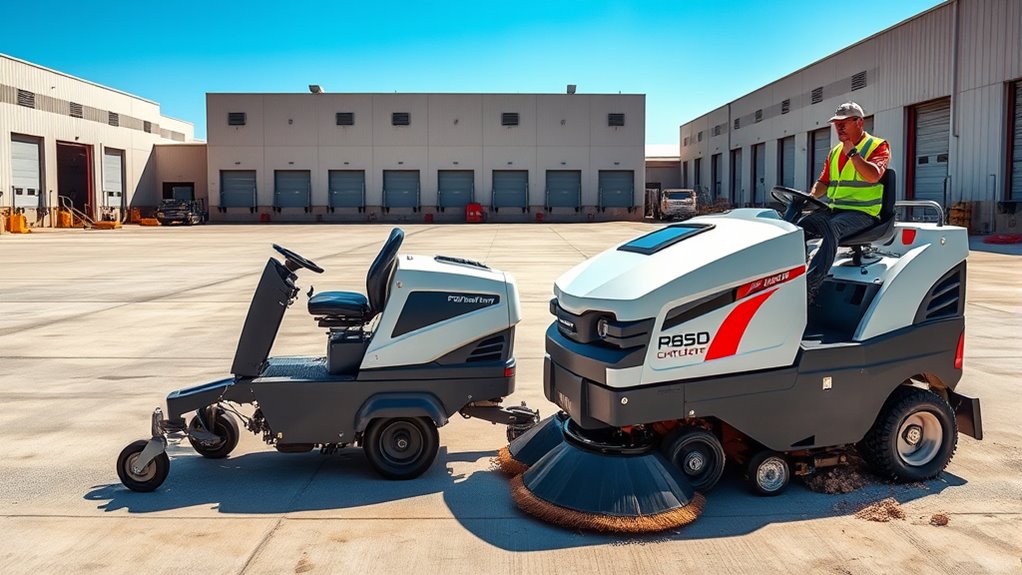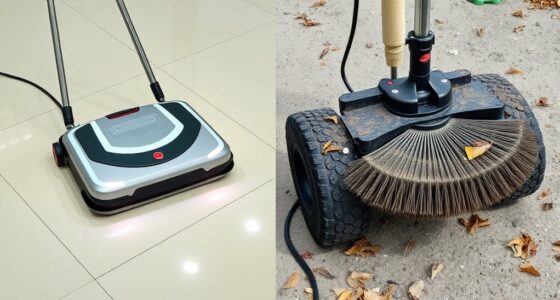If you’re choosing between walk-behind and ride-on sweepers, consider your space size and cleaning needs. Walk-behind models are great for tight spots, small facilities, or detailed work, offering easy maneuverability and lower costs. Ride-on sweepers excel in large outdoor yards or industrial areas, providing faster coverage and longer operation times. To find out which fits your environment best and the right features for your use, keep exploring the options available.
Key Takeaways
- Walk-behind sweepers are ideal for small, confined spaces with tight corners, offering superior maneuverability.
- Ride-on sweepers excel in large outdoor areas, providing higher efficiency and longer operational hours.
- Smaller, simpler, and cheaper to maintain, walk-behind models suit low to medium cleaning demands.
- Larger, more advanced ride-on sweepers are suited for extensive, continuous cleaning in industrial or outdoor environments.
- Selection depends on area size, complexity, and operational needs, balancing cost, maneuverability, and efficiency.

When choosing between walk-behind and ride-on sweepers, understanding their differences can help you make an informed decision for your cleaning needs. Both types serve the purpose of maintaining large areas, but their suitability depends on factors like battery life, maintenance costs, and the specific environment you’ll be working in. Walk-behind sweepers are generally more compact and easier to maneuver, making them ideal for smaller spaces or areas with tight corners. They tend to have shorter battery life per charge, which means you might need to plan for more frequent recharges during extended cleaning sessions. On the other hand, ride-on sweepers usually come with larger batteries, offering longer operational hours before needing a recharge. This makes them more efficient for large-scale cleaning tasks, especially when downtime needs to be minimized. Additionally, some models incorporate advanced features such as programmable settings or ergonomic designs to enhance user comfort and efficiency. Maintenance costs also vary considerably between the two types. Walk-behind sweepers typically have simpler mechanisms, resulting in lower overall maintenance expenses. Their smaller size means fewer complex parts, and repairs tend to be quicker and less costly. Conversely, ride-on sweepers, with their larger systems and more advanced features, often require more specialized maintenance. The higher number of components and their increased complexity can lead to increased upkeep costs over time. However, because ride-on sweepers cover more ground in less time, they can be more cost-effective in terms of labor and operational efficiency, offsetting some of the higher maintenance expenses. In deciding where each fits best, consider the size and layout of the area you need to clean. For smaller facilities, warehouses, or spaces with intricate layouts, a walk-behind sweeper provides agility and ease of use at a lower initial investment and maintenance cost. If you’re responsible for large outdoor lots, industrial yards, or expansive commercial spaces, a ride-on sweeper offers the advantage of greater battery capacity and productivity. The longer battery life allows you to clean bigger areas without frequent stops, saving time and reducing the number of recharges needed throughout the day. When evaluating options, it’s also helpful to consider the maintenance requirements and how they align with your operational capabilities. Ultimately, your choice should balance operational efficiency with ongoing costs. If your priority is quick, flexible cleaning in confined spaces, a walk-behind sweeper might be the best fit. For large-scale, continuous cleaning that demands longer battery endurance and higher throughput, investing in a ride-on model makes sense. By understanding these key differences, especially regarding battery life and maintenance costs, you’ll be better equipped to select the sweeper that aligns with your cleaning objectives and budget.
Frequently Asked Questions
What Is the Typical Lifespan of Each Sweeper Type?
You can expect a walk-behind sweeper to last around 3 to 5 years, with proper maintenance, while ride-on sweepers generally have a durability comparison of 7 to 10 years. Replacement intervals depend on usage and care, but ride-on models often offer a longer lifespan due to their sturdier build. Regular maintenance helps maximize each type’s durability, ensuring you get the most from your investment.
How Much Maintenance Do Walk-Behind and Ride-On Sweepers Require?
You’ll find that walk-behind sweepers generally require less maintenance, making them easier to keep in top shape, while ride-on sweepers need a bit more attention for their larger components. Maintenance costs vary, but both demand regular operator training to guarantee the best performance and longevity. With proper care, you’ll enjoy smooth operation and fewer surprises, whether you choose the nimble walk-behind or the robust ride-on model.
Are There Specific Safety Concerns for Operators of Each Type?
Operator safety is crucial with both sweepers. Walk-behind models may pose ergonomic concerns if you experience strain from prolonged pushing or bending, so proper posture is essential. Ride-on sweepers reduce physical effort, but you should still be aware of safety features like seat belts and emergency stops. Always follow manufacturer guidelines to minimize risks, stay alert, and guarantee your workspace is clear to prevent accidents and promote safe operation.
Can These Sweepers Be Used Effectively Indoors?
Yes, you can use these sweepers effectively for indoor cleaning, especially in spaces with restrictions. Walk-behind sweepers are ideal for tight areas and detailed cleaning, allowing you to maneuver easily around obstacles. Ride-on sweepers cover larger spaces quickly, but they might be less suitable for small or cluttered indoor environments. Choose based on your space’s size and layout to guarantee efficient and safe cleaning.
What Is the Initial Cost Difference Between Walk-Behind and Ride-On Sweepers?
You’ll find that the initial cost difference between walk-behind and ride-on sweepers is significant—ride-on models can cost two to three times more. For equipment affordability, a walk-behind sweeper often starts around $3,000, while a ride-on can jump to $10,000 or more. This makes walk-behind sweepers more accessible for smaller budgets, but ride-on sweepers offer greater efficiency for larger areas.
Conclusion
Choosing between walk-behind and ride-on sweepers depends on your needs. Imagine maneuvering a compact walk-behind through tight corners, perfect for detailed cleaning. Now picture yourself effortlessly covering large areas with a ride-on, gliding smoothly across open spaces. Both have their place—one offers precision where space is limited, the other efficiency over expansive surfaces. By understanding their differences, you can select the right sweeper to keep your environment spotless and your workflow seamless.








